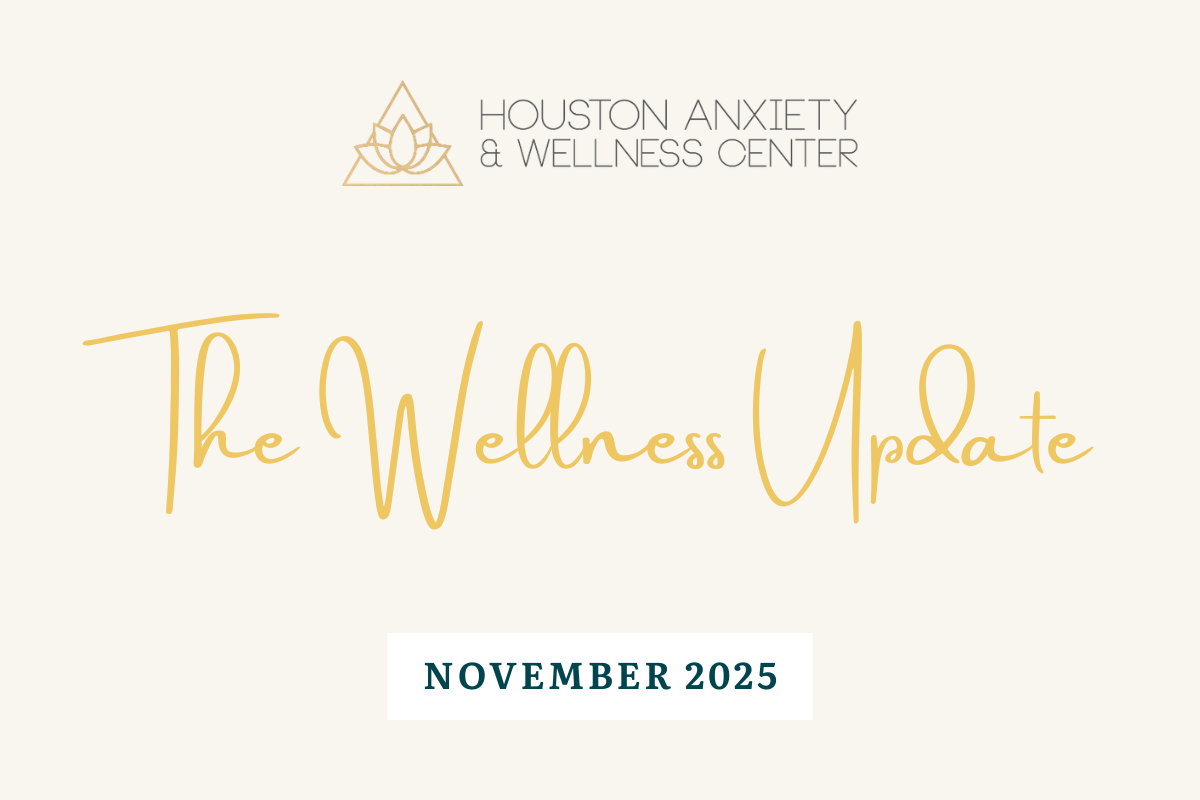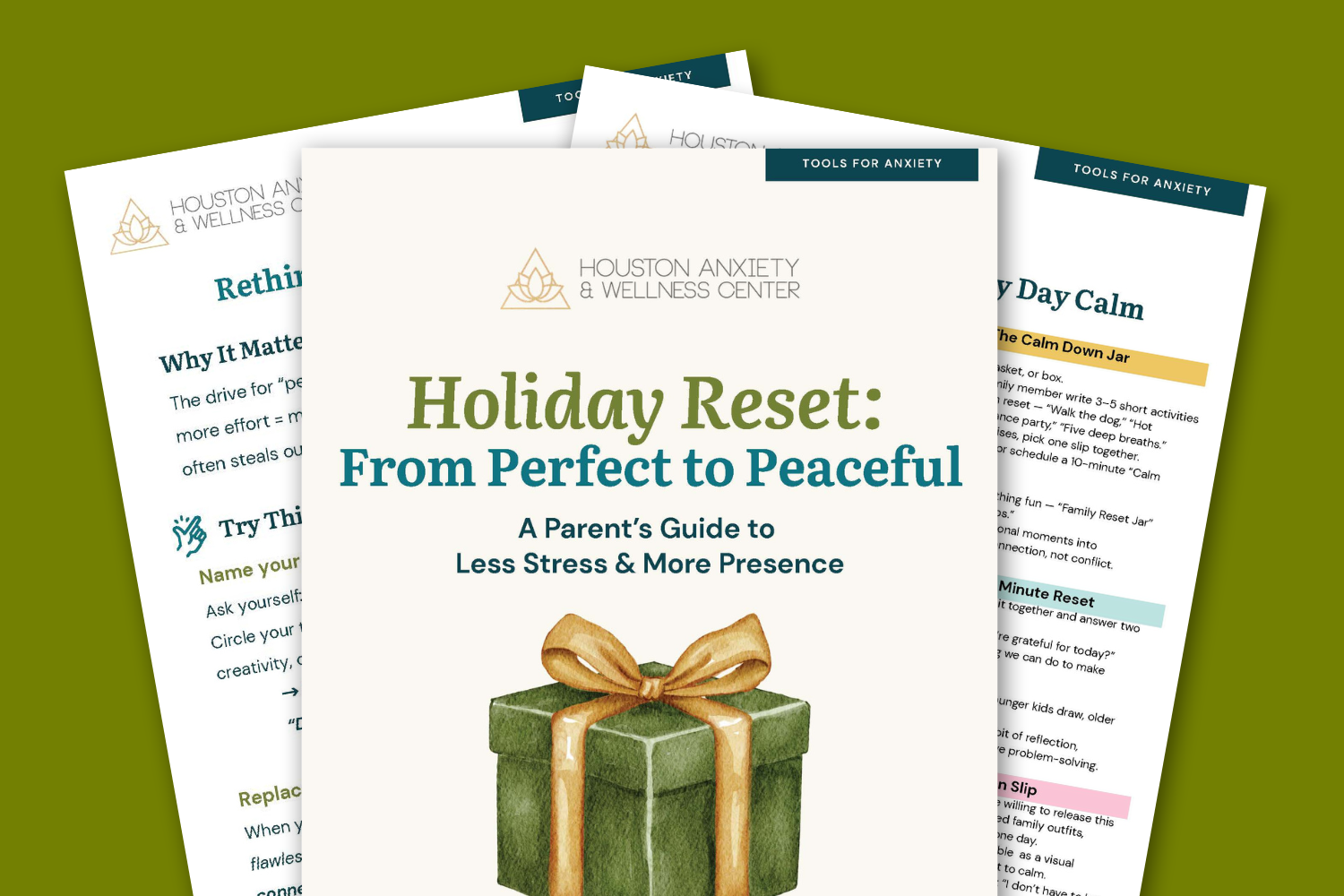How to Protect Your Peace This Holiday Season
Feeling the holiday chaos creeping in? This month’s update brings easy, gentle ways to slow down, set boundaries, and enjoy what really matters.

As the holidays approach, a time filled with both joy and pressure, it’s common for anxiety to bubble up more than usual. Maybe it’s the endless to-do lists, travel plans, family dynamics, mid term exams or simply the change in routine. Anxiety rarely arrives all at once; it builds, slowly and steadily, like lava rising inside a volcano.
Imagine that lava starting in your toes. On calm days, it sits low, warm but manageable. On stressful days, or months, it creeps up your legs, your chest, and, eventually, your neck. When it gets that high, it doesn’t take much - a small comment, a traffic jam, a spilled cup of coffee - for the volcano to erupt.
The goal of anxiety management isn’t to eliminate the lava entirely. Anxiety is part of being human—it helps us stay alert and respond to challenges. The goal is to lower the lava so it never reaches the point of eruption. That’s where your anxiety toolkit comes in.
Preventative care for anxiety is like regular maintenance for your emotional health. It’s what helps you stay steady and grounded before anxiety builds to a breaking point.
Mindfulness doesn’t mean sitting perfectly still for an hour—it’s about noticing the present moment without judgment. When you tune into your breath, body, or surroundings, you’re signaling to your nervous system: I am safe right now.
Try this short daily practice: close your eyes, place a hand on your chest, and take three deep breaths. Feel the rise and fall. This simple act helps lower your baseline anxiety over time.
Box breathing is a powerful, evidence-based CBT tool often used by first responders and athletes to regulate the body’s stress response:
Repeat this cycle a few times when you start to feel the lava rise. It slows your heart rate and tells your brain it’s safe to relax.
A brisk 10-minute walk, stretching, or yoga can dramatically shift anxiety levels. Movement releases endorphins, while time outdoors grounds you through your senses—the feeling of air on your skin, the sound of leaves, the rhythm of your steps. This is mindfulness in motion.
Music is a direct line to the emotional brain. Create a “calm playlist” filled with songs that remind you of peace, safety, or joy. Listening when you feel tense helps regulate your emotions and lowers physiological arousal.
The holidays often bring pressure about how we “should” feel or show up. But grace is one of the most powerful anxiety management tools there is. You are allowed to show up as you are—imperfectly human. Remember: there is no growth in shame; shame fuels anxiety, while self-compassion cools the lava.
Sometimes, despite our best efforts, anxiety builds fast. When that happens, we move from preventative care to reaction management. Here’s how to keep a potential eruption under control:
In CBT, awareness is the first step toward change. Simply saying, “I’m noticing my anxiety is really high right now,” creates a small but powerful pause. It separates you from the emotion, giving you room to respond intentionally rather than react impulsively.
Anxiety often tells us stories that feel true but aren’t grounded in fact. When your thoughts spiral, pause and ask: “What do I know to be true right now?”
This helps anchor you in reality and reduces catastrophic thinking.
When panic feels close, use temperature to shift your body’s state. Splash cold water on your face, hold an ice cube, or step outside briefly. This activates the body’s “dive reflex,” slowing your heart rate and helping you regain calm.
Cognitive reframing is a core CBT tool. Instead of “I can’t handle this,” try:
“This feeling is uncomfortable, but it’s temporary.”
“I’ve managed anxiety before; I can manage it again.”
This shift quiets anxious thoughts and reminds you of your resilience.
When your thoughts race, use this sensory grounding tool:
It’s a fast and effective way to bring your attention back to the present moment.
One of the most compassionate principles in therapy is that you can always begin again.
Progress isn’t about how rarely you feel anxious—it’s about how often you notice it and choose to respond with care. Every time you pause, breathe, and redirect your energy, you’re lowering your lava.
Maybe you forget your breathing practice for a week. Maybe you lose your patience at a family gathering. That’s okay. The moment you remember to come back to yourself—to pause and respond in alignment with your values—you’re practicing growth.
As the holidays draw near, may you give yourself permission to rest, to show up as you are, and to practice grace for yourself and others. You’re not failing when you feel anxious; you’re learning to manage the lava. And with each pause, each breath, and each moment of awareness, you’re cooling the volcano—one day at a time.
If you or someone you know could benefit from working with an anxiety specialist to learn new coping skills to help manage the lava, schedule a free consultation call or initial evaluation with one of our anxiety therapists at Houston Anxiety and Wellness Center. You don’t have to manage alone, we’re here to help.
Privacy Notice: By providing your email, you understand this resource is educational only and doesn't establish a therapeutic relationship. We use Flodesk (non-HIPAA compliant) to deliver this content and general practice updates. Your email will not be shared with third parties.
As the holidays approach, a time filled with both joy and pressure, it’s common for anxiety to bubble up more than usual. Maybe it’s the endless to-do lists, travel plans, family dynamics, mid term exams or simply the change in routine. Anxiety rarely arrives all at once; it builds, slowly and steadily, like lava rising inside a volcano.
Imagine that lava starting in your toes. On calm days, it sits low, warm but manageable. On stressful days, or months, it creeps up your legs, your chest, and, eventually, your neck. When it gets that high, it doesn’t take much - a small comment, a traffic jam, a spilled cup of coffee - for the volcano to erupt.
The goal of anxiety management isn’t to eliminate the lava entirely. Anxiety is part of being human—it helps us stay alert and respond to challenges. The goal is to lower the lava so it never reaches the point of eruption. That’s where your anxiety toolkit comes in.
Preventative care for anxiety is like regular maintenance for your emotional health. It’s what helps you stay steady and grounded before anxiety builds to a breaking point.
Mindfulness doesn’t mean sitting perfectly still for an hour—it’s about noticing the present moment without judgment. When you tune into your breath, body, or surroundings, you’re signaling to your nervous system: I am safe right now.
Try this short daily practice: close your eyes, place a hand on your chest, and take three deep breaths. Feel the rise and fall. This simple act helps lower your baseline anxiety over time.
Box breathing is a powerful, evidence-based CBT tool often used by first responders and athletes to regulate the body’s stress response:
Repeat this cycle a few times when you start to feel the lava rise. It slows your heart rate and tells your brain it’s safe to relax.
A brisk 10-minute walk, stretching, or yoga can dramatically shift anxiety levels. Movement releases endorphins, while time outdoors grounds you through your senses—the feeling of air on your skin, the sound of leaves, the rhythm of your steps. This is mindfulness in motion.
Music is a direct line to the emotional brain. Create a “calm playlist” filled with songs that remind you of peace, safety, or joy. Listening when you feel tense helps regulate your emotions and lowers physiological arousal.
The holidays often bring pressure about how we “should” feel or show up. But grace is one of the most powerful anxiety management tools there is. You are allowed to show up as you are—imperfectly human. Remember: there is no growth in shame; shame fuels anxiety, while self-compassion cools the lava.
Sometimes, despite our best efforts, anxiety builds fast. When that happens, we move from preventative care to reaction management. Here’s how to keep a potential eruption under control:
In CBT, awareness is the first step toward change. Simply saying, “I’m noticing my anxiety is really high right now,” creates a small but powerful pause. It separates you from the emotion, giving you room to respond intentionally rather than react impulsively.
Anxiety often tells us stories that feel true but aren’t grounded in fact. When your thoughts spiral, pause and ask: “What do I know to be true right now?”
This helps anchor you in reality and reduces catastrophic thinking.
When panic feels close, use temperature to shift your body’s state. Splash cold water on your face, hold an ice cube, or step outside briefly. This activates the body’s “dive reflex,” slowing your heart rate and helping you regain calm.
Cognitive reframing is a core CBT tool. Instead of “I can’t handle this,” try:
“This feeling is uncomfortable, but it’s temporary.”
“I’ve managed anxiety before; I can manage it again.”
This shift quiets anxious thoughts and reminds you of your resilience.
When your thoughts race, use this sensory grounding tool:
It’s a fast and effective way to bring your attention back to the present moment.
One of the most compassionate principles in therapy is that you can always begin again.
Progress isn’t about how rarely you feel anxious—it’s about how often you notice it and choose to respond with care. Every time you pause, breathe, and redirect your energy, you’re lowering your lava.
Maybe you forget your breathing practice for a week. Maybe you lose your patience at a family gathering. That’s okay. The moment you remember to come back to yourself—to pause and respond in alignment with your values—you’re practicing growth.
As the holidays draw near, may you give yourself permission to rest, to show up as you are, and to practice grace for yourself and others. You’re not failing when you feel anxious; you’re learning to manage the lava. And with each pause, each breath, and each moment of awareness, you’re cooling the volcano—one day at a time.
If you or someone you know could benefit from working with an anxiety specialist to learn new coping skills to help manage the lava, schedule a free consultation call or initial evaluation with one of our anxiety therapists at Houston Anxiety and Wellness Center. You don’t have to manage alone, we’re here to help.

Feeling the holiday chaos creeping in? This month’s update brings easy, gentle ways to slow down, set boundaries, and enjoy what really matters.

Trade chaos for calm this season. Our Holiday Reset guide helps parents reduce stress, quiet anxiety, and find more presence during the holidays.